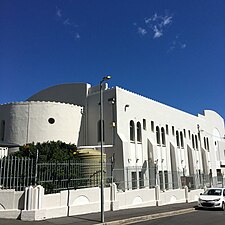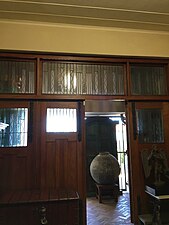Vredehoek Shul
| Cape Town Orthodox Hebrew Congregation | |
|---|---|
 The former synagogue in 2023 | |
| Religion | |
| Affiliation | Orthodox Judaism |
| Rite | Ashkenazi |
| Status | Closed (1993) |
| Location | |
| Location | 16 Vredehoek Ave, Vredehoek, Cape Town, South Africa |
| Geographic coordinates | 33°56′13″S 18°25′09″E / 33.9369°S 18.4191°E |
| Architecture | |
| Architect(s) | John Joseph Ingber |
| Type | Synagogue |
| Style | Art Deco |
| Completed | 1939 |
The Vredehoek Shul, formally the Cape Town Hebrew Congregation, was a
History
During the first half of the twentieth century, many Jewish immigrants from Europe, especially
In 1951, its cantor, Jacob Lichterman assisted with a historic court hearing in Cape Town's Supreme Court. Jack Ryback requested an order declaring his wife and son dead. His family were last known to have been living in the Warsaw Ghetto in 1942. According to the Jewish Telegraphic Agency: "The description of the end of the ghetto was presented by Jacob Lichterman, who had himself lived in Warsaw until 1943 and who had witnessed the destruction by fire of the ghetto. In an affidavit presented by Mr. Ryback, Mr. Lichterman, cantor of the Vredehoek Synagogue, stated that during 1945 and 1946 he had assisted the Central Committee of Jews in Poland with the compilation of a list of the few survivors of the holocaust and that the name of Ryback had not appeared among the survivors. He added that he believed that the Rybacks had either died in the ghetto or had been removed earlier to be exterminated in a death camp."[7]
It was one of two synagogues in Vredehoek, the other being the Tifereth Israel Synagogue (Schoonder Street Shul), also known as the “round shul”. It was designed by architect Max Policansky and opened in 1952 and was demolished in 2001.[8][4] The City Bowl had been the hub of Jewish life, but in the second half of the twentieth century, many Jewish residents began to move to the Southern Suburbs and Sea Point.[9]
Gallery
-
Wedding Chuppah at Vredehoek Shul, 1979
-
Rear view of former Vredehoek Shul, 2024
-
Front and side view of former vredehoek Shul, 2024
-
Rabbi Mirvish Avenue beside the synagogue, 2024
-
Interior, 2024
-
Vredehoek Shul doors, 2024
References
- ^ a b Synagogue Artefacts. Accessed on 12 September 2023
- ^ Vredehoek Synagogue Cape Town - Final Service, 8 August 1993 YouTube. 8 August 1993. Accessed on 12 September 2023
- ^ Private Collections' New Showroom Visi. 15 October 2018
- ^ a b c Declaring urban conservation areas: the Art Deco townscape of Vredehoek, Cape Town University of Cape Town. 2017
- ^ Abe Mirvish South African Jewish Museum Archives. Retrieved on 7 November 2023
- ^ Where the streets bear our names South African Jewish Report. 27 February 2020
- ^ Capetown Court Hears Description of Nazi Slaughter of Jews Jewish Telegraphic Agency. 21 November 1951
- ^ Synagogue Artefacts. Accessed on 12 September 2023
- ISBN 9783662668870. Retrieved 21 September 2023.






